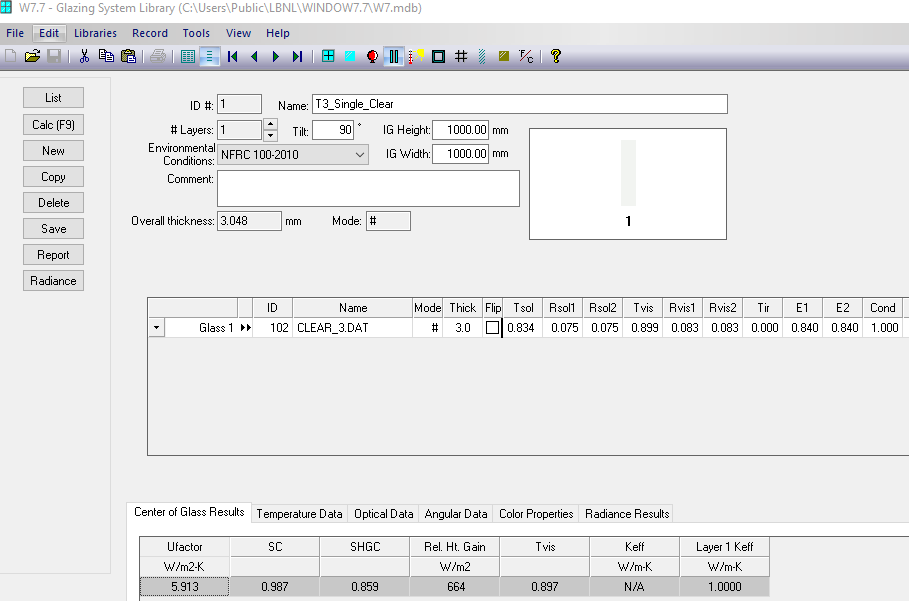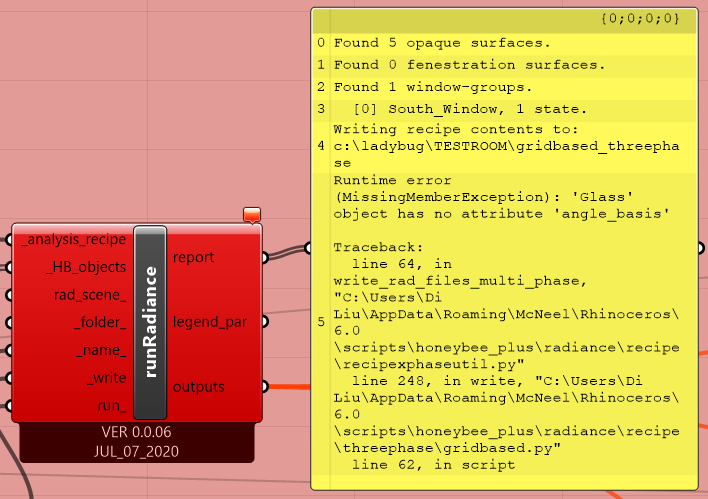Hi there!
Hope you have had a good summer by far ![]()
Recently I am exploring 3-Phase recipe in a shoebox room with one window, which covers the whole south facade. I encounter an error regarding radGlassMat to WindowGroup.
Description:
I intend to use a single_clear_glazing material with 0.7 visible transmittance. I tried two ways to create the glass material, radBSDFMat and radGlassMat. I test them respectively.
Please see below:
I created the simple glass material in WINDOW7.7. Then I connected the xml file to radBSDFMat and assigned it to WindowGroup. The results showed that radBSDFMat works fine and generates DA and UDI outputs. Please see the below image for the single clear glazing I created:
Then I tired radGlassMat to connect to windowgroup. It comes out with an error. No output was generated:
I am not sure the reason behind the error. According to the reading of The Three-Phase method for simulating complex Fenestration with Radiance. A McNeil, LBNL. (Last revision: 2014), three-phase method is described as:
Flux transfer is broken into the following three phases for independent simulation:
- Sky to exterior of fenestration
- Transmission through fenestration
- Interior of fenestration into the simulated space
A matrix is used to characterize each phase of light transport. The input condition, sky luminance, is a vector. The result, illuminance values or a rendering, is also vector. The result is achieved by multiplying the sun vector by each matrix representing each phase of flux transfer. The process is described by the following equation:
i = VTDs, or, I = VTDS
i = point in time illuminance or luminance result
I= matrix containing time series of illuminance or luminance result
V = view matrix, (created with Radiance_rcontrib, vwrays)
T = transmission matrix. (created by Radiance_genBSDF)
D = daylight matrix. Daylight matrix contains luminous flux transfer coefficient from the sky divisions to the window’s incident Klems divisions. (created by Radiance_gensklemsamp, rcontrib)
Is it because the single_clear_glazing cannot behave in the transmission matrix so radGlassMat cause an error?
Also, with reviewing discussions in the discourse, I understand 3-phase method is particularly good when using BSDF material. With that said, I am wondering if single clear glazing material is suitable for 3-phase method, and if radGlassMat is allowed to apply to it.
Plus, I am not very clear about the definition of WindowGroup and Window State. Any reference about these concepts will be appreciated.
Thanks for your comments and suggestions.
Error_3Phase_SingleLayerGlazing_8.11.gh (545.6 KB)



 You have to do some extra work to make that happen.
You have to do some extra work to make that happen.